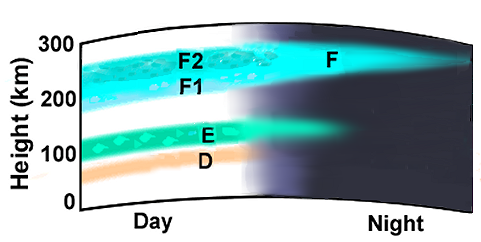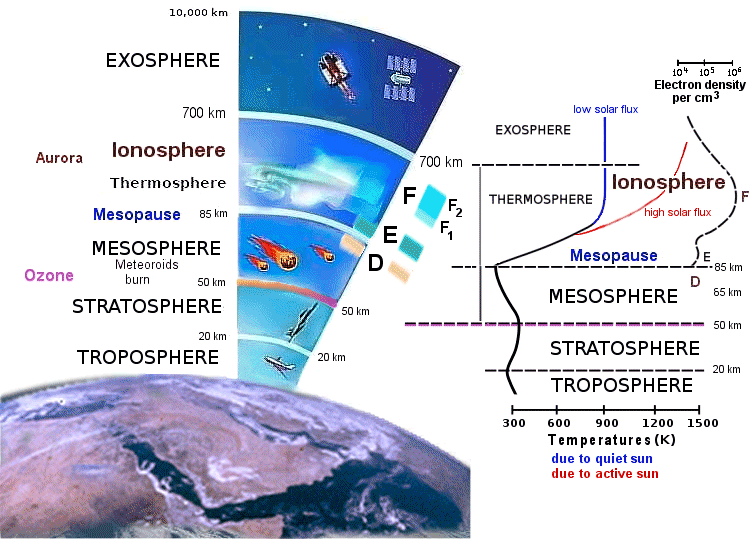 Earth's Atmosphere and Ionosphere
Earth's Atmosphere and Ionosphere
Region vs. Layer
In various technical and scientific articles, the terms "layer" and "region" are often used interchangeably, leading to confusion, particularly in the context of the Earth's atmosphere and ionosphere. An extensive review of online resources, utilizing AI tools (such as ChatGPT, Grok, Copilot, and Gemini), provided conflicting results. However, using authoritative sources like NOAA and NASA to clarify the difference between "region" and "layer" in atmospheric and ionospheric contexts yields the following results:
In the Earth's atmosphere and ionosphere, "region" and "layer" represent distinct methods of categorizing the vertical structure of the atmosphere. These classifications are based on unique characteristics such as temperature, composition, or ionization. The following is a clear explanation of each term and their differences.
Atmosphere: Layers
The Earth's atmosphere is divided into layers based primarily on temperature gradients (how temperature changes with altitude). These layers are defined by their thermal characteristics and are part of the neutral atmosphere (where neutral gases dominate). The main atmospheric layers, from the surface upward, are:
- Troposphere (0–12 km): The lowest layer, where weather occurs. Temperature decreases with altitude.
- Stratosphere (12–50 km): Contains the ozone layer, which absorbs UV radiation, causing temperature to increase with altitude.
- Mesosphere (50–85 km): Temperature decreases with altitude, reaching the coldest point in the atmosphere (~-90°C).
- Thermosphere (85–600 km): Temperature increases dramatically due to solar radiation absorption, but the air is very thin.
- Exosphere (600 km and beyond): The outermost layer, where particles are so sparse they can escape into space.
These layers are defined by neutral gas behavior and temperature profiles, not ionization.
Ionosphere: Regions
The ionosphere is a part of the atmosphere (primarily within the thermosphere and upper mesosphere) where ionization occurs due to solar radiation (UV and X-rays) stripping electrons from neutral atoms and molecules, creating a plasma of ions and free electrons. The ionosphere is divided into regions based on electron density and ionization levels, which affect radio wave propagation and other phenomena. These regions ftom top to bottom are:
- F Region (~150–800 km): The most significant region for long-distance radio communication, with the highest electron density. It splits into F1 (lower, ~150–250 km) and F2 (higher, ~250–800 km) layers during the day due to varying ionization levels. The higher region persists at night and is critical for high-frequency radio propagation.
- E Region (~90–150 km): Lower electron density than the F region. It refracts medium-frequency radio waves and is stronger during the day.
- D Region (~60–90 km): The lowest ionospheric region, with low electron density. It forms during the day due to solar radiation and weakens at night. It absorbs high-frequency radio waves.

Figure 2: Ionospheric regions illustration
These regions are not strictly defined by temperature but by the degree of ionization and electron concentration, which vary with altitude, time of day, solar activity, and geographic location.
Key Differences: Region vs. Layer
| Aspect | Layer (Atmosphere) | Region (Ionosphere) |
|---|---|---|
| Basis of Division | Temperature gradient and neutral gas behavior | Electron density and ionization levels |
| Location | Entire atmosphere (surface to exosphere) | Primarily thermosphere and upper mesosphere |
| Examples | Troposphere, stratosphere, thermosphere | D, E, F regions |
| Primary Property | Thermal characteristics | Ionization and plasma properties |
| Function/Relevance | Weather, climate, air density | Radio wave propagation, space weather effects |
Relationship Between Layers and Regions
- The ionosphere overlaps with the mesosphere, thermosphere, and sometimes the upper stratosphere.
- For example:
- The D region lies mostly in the mesosphere.
- The E region spans the upper mesosphere and lower thermosphere.
- The F region is entirely within the thermosphere.
- The ionosphere is not a distinct atmospheric layer but a set of regions defined by ionization within these layers.
- The thermosphere contains most of the ionosphere because its high-altitude, low-density environment allows solar radiation to ionize particles effectively.
Why the Distinction Matters
- Atmospheric layers are critical for understanding weather, climate, and aviation (e.g., the troposphere for weather, the stratosphere for jet travel).
- Ionospheric regions are essential for communication and navigation systems (e.g., GPS, radio, and satellite operations) because ionized particles affect radio wave propagation and can cause signal disruptions during solar storms.
Summary
Layers describe the atmosphere's thermal structure, while regions in the ionosphere focus on ionization and electron density, with the two systems overlapping but serving different scientific purposes.
List of sources
- Atmospheric Layers lumenlearning
- Atmospheric layers and pressure, Troposphere, Stratosphere, Mesosphere and Thermosphere Science online
- Atmospheric Structure Geosciences LibreTexts
- Definition of the Ionospheric Regions (Structures) NOAA > NESDIS > NCEI (formerly NGDC)
- D-Region Absorption Prediction (D-RAP) Model Archive NOAA
- D-region | lowest ionospheric region Britannica
- E-region | middle ionospheric region Britannica
- F-region | highest region of the ionosphere Britannica
- F region Wikipedia
- Earth’s Atmosphere: A Multi-layered Cake NASA
- Introduction to HF Radio Propagation SWS Australian Gov
- Ionospheric Layers: D, E, F, F1, F2, Regions Electronics-Notes, Ian Poole
- Layers of Earth's Atmosphere UCAR, NSF NCAR
- Layers of the Atmosphere National Oceanic and Atmospheric Administration—NOAA
- Layers of the Earth’s Atmosphere Sciencefacts Net, NOAA
- Ozone Layer (Stratosphere) NOAA
- Region vs Layer Bing search
- Region vs Layer Duckduckgo search
- Region vs Layer Google search
- What is the Ionosphere? Super Dual Auroral Radar Network (SDARN), Canada
Repeat visits counted as new after 24 hours.
The number of visits (graphs displayed below) peaked during HF propagation disruptions.
Visits (per day) since 2022
Visits (per day) during the last 3 months
Visits (per day) during the last month
Hourly visits today
